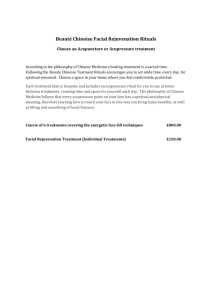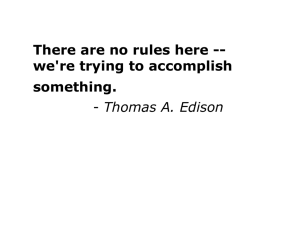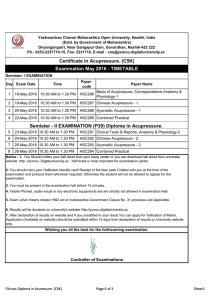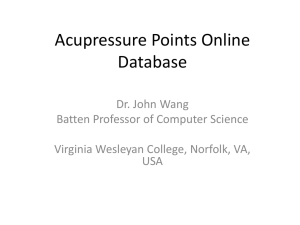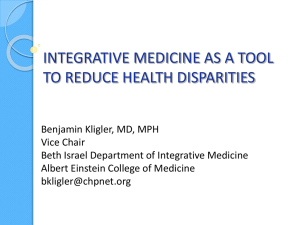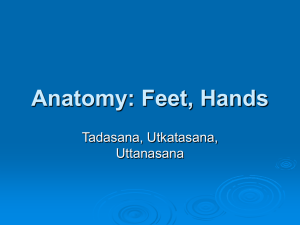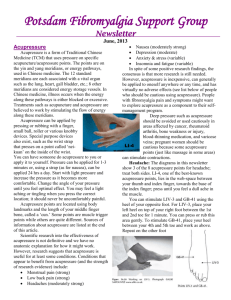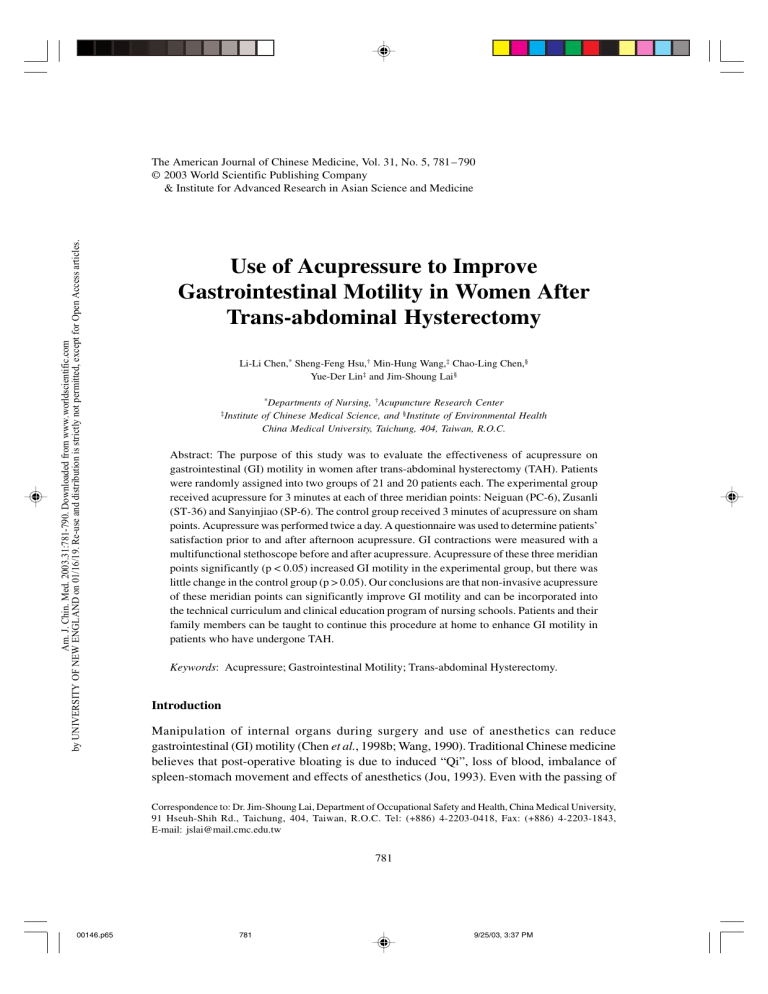
Am. J. Chin. Med. 2003.31:781-790. Downloaded from www.worldscientific.com by UNIVERSITY OF NEW ENGLAND on 01/16/19. Re-use and distribution is strictly not permitted, except for Open Access articles. The American Journal of Chinese Medicine, Vol. 31, No. 5, 781–790 © 2003 World Scientific Publishing Company & Institute for Advanced Research in Asian Science and Medicine Use of Acupressure to Improve Gastrointestinal Motility in Women After Trans-abdominal Hysterectomy Li-Li Chen,* Sheng-Feng Hsu,† Min-Hung Wang,‡ Chao-Ling Chen,§ Yue-Der Lin‡ and Jim-Shoung Lai§ ‡Institute *Departments of Nursing, †Acupuncture Research Center of Chinese Medical Science, and §Institute of Environmental Health China Medical University, Taichung, 404, Taiwan, R.O.C. Abstract: The purpose of this study was to evaluate the effectiveness of acupressure on gastrointestinal (GI) motility in women after trans-abdominal hysterectomy (TAH). Patients were randomly assigned into two groups of 21 and 20 patients each. The experimental group received acupressure for 3 minutes at each of three meridian points: Neiguan (PC-6), Zusanli (ST-36) and Sanyinjiao (SP-6). The control group received 3 minutes of acupressure on sham points. Acupressure was performed twice a day. A questionnaire was used to determine patients’ satisfaction prior to and after afternoon acupressure. GI contractions were measured with a multifunctional stethoscope before and after acupressure. Acupressure of these three meridian points significantly (p < 0.05) increased GI motility in the experimental group, but there was little change in the control group (p > 0.05). Our conclusions are that non-invasive acupressure of these meridian points can significantly improve GI motility and can be incorporated into the technical curriculum and clinical education program of nursing schools. Patients and their family members can be taught to continue this procedure at home to enhance GI motility in patients who have undergone TAH. Keywords: Acupressure; Gastrointestinal Motility; Trans-abdominal Hysterectomy. Introduction Manipulation of internal organs during surgery and use of anesthetics can reduce gastrointestinal (GI) motility (Chen et al., 1998b; Wang, 1990). Traditional Chinese medicine believes that post-operative bloating is due to induced “Qi”, loss of blood, imbalance of spleen-stomach movement and effects of anesthetics (Jou, 1993). Even with the passing of Correspondence to: Dr. Jim-Shoung Lai, Department of Occupational Safety and Health, China Medical University, 91 Hseuh-Shih Rd., Taichung, 404, Taiwan, R.O.C. Tel: (+886) 4-2203-0418, Fax: (+886) 4-2203-1843, E-mail: jslai@mail.cmc.edu.tw 781 00146.p65 781 9/25/03, 3:37 PM Am. J. Chin. Med. 2003.31:781-790. Downloaded from www.worldscientific.com by UNIVERSITY OF NEW ENGLAND on 01/16/19. Re-use and distribution is strictly not permitted, except for Open Access articles. 782 00146.p65 L.-L. CHEN et al. gas after abdominal surgery, these patients still suffer from various temporary disorders that require immediate care such as abdominal distention, loss of appetite, reduced bowel sounds, nausea and vomiting (Jair, 1997; Liou, 1994). Wang (1990) reported that obstetric and gynecological surgery patients frequently suffer from bloating that affects appetite, sleep, wound healing and organ recovery (Chen et al., 1998a). Thus, proper care of these patients becomes an important task for nurses. Traditionally, medication, heat pads, food intake, change of resting position, and early activity are used to promote early return of GI motility in abdominal surgery patients (Su, 1995; Guu and Lii, 1996; Shyu and Sonq, 1997). Traditional Chinese medicine was seldom used to treat these patients. In traditional Chinese medicine, treatment of GI motility problems includes herbal medicine, acupuncture and acupressure (Liou, 1995; Suen, 1997). Acupressure was used to treat patients as early as 2000 years ago in China (Liou, 1995). In contrast to acupuncture that uses needles to puncture the meridian points, acupressure uses fingers to massage or press on specific regions of body surface or meridian points. Acupressure has been used to adjust physiological functions, treat pathological conditions, and for two-way adjustment of imbalance in body systems to maintain health (Liou, 1995; Lin and Ian, 1995). Several reports indicated that pressing and kneading on Zusanli (ST-36) and Sanyinjiao (SP-6) meridian points for 1 to 3 minutes relieved post-gynecological and abdominal surgery bloating 94.4–98.7% (Chen et al.,1998a and b; Lii and Lii, 1996). Ho et al. (1996) indicated that pressing of Neiguan (PC-6) can reduce nausea and vomiting problems associated with Cesarean section. However, Bellquomini et al. (1994) reported that acupressure at PC-6 can only reduce nausea but not vomiting. Studies of Steele et al. (2001) and Norheim et al. (2001) indicated that using Sea-Bands (Wrist-bands, Sea-Band UK, Ltd., Leicester, UK) with acupressure buttons at PC-6 can reduce the nausea and vomiting of pregnancy. Chen et al. (1998b) reported that acupressure at ST-36 and PC-6 can increase GI motility during post-Cesarean section abdominal distention. Based on the aforementioned observations, this study examined the combined effect of three meridian points, ST-36, SP-6 and PC-6, on GI motility in post trans-abdominal hysterectomy (TAH) patients. Materials and Methods Experimental Design Patients were randomly assigned into two groups of 21 and 20 patients each. Patients were not informed whether they were in experimental or control groups. The experimental group received acupressure on three meridian points, PC-6, ST-36 and SP-6. The control group received sham acupressure on non-meridian points on the tibia or radial bone surface approximately 3– 4 cm from the corresponding three meridian points. Patients were interviewed one day prior to surgery and were asked to sign a “consent form” (the protocol was reviewed by the Institutional Review Board and permission was waived due to the noninvasive nature of the study). The first acupressure was performed post-surgery at the 5th hour in order to allow patients to rest and recover from anesthesia on the operation day. On 782 9/25/03, 3:37 PM Am. J. Chin. Med. 2003.31:781-790. Downloaded from www.worldscientific.com by UNIVERSITY OF NEW ENGLAND on 01/16/19. Re-use and distribution is strictly not permitted, except for Open Access articles. ACUPRESSURE AND BOWEL MOTILITY 783 the 1st day after surgery, acupressure was performed at 10am and 2pm each day for 3 days. Family members of patients were taught the acupressure procedure on the 3rd day to continue the acupressure at home. The control group received acupressure at non-meridian points proximal to the acupressure points. GI motility was measured by stethoscope prior to and following the afternoon acupressure. Study Subjects Patients undergoing TAH without neoplasm at a Mid-Taiwan Teaching Hospital were recruited for this study. Experimental procedures were explained to the subjects, they were asked to sign a “consent form” and were assigned a number according to the time of admission. The numbers were assigned to experimental or control groups by computer randomization. General anesthesia was used for all patients. There were 21 experimental and 20 control patients. The average age was 44.86 ± 8.0 years and 44.95 ± 7.44 years for experimental and control groups, respectively. Questionnaire and Stethoscope A questionnaire form was designed and divided into four parts and the answers were recorded by the interviewer. The first part of the questionnaire included basic information, history and hospital admission record. The second part included time and date of acupressure, experience of pain at the time of acupressure, post-surgical activity, and food intake and bowel movements on the previous day. The third part included GI motility before and after acupressure, Visual Analog Scale of self-awareness of GI motility, and the number of GI motility. The fourth part included the degree of patient satisfaction after the acupressure, with higher the score, the higher the satisfaction. A. Validation of the questionnaire and acupressure procedure: (1) The questionnaire was constructed with input from 13 specialists, including basic and clinical professors, nurses and statisticians. Clinical specialists were in the following areas: traditional Chinese medicine physicians and nurses, specialists in gastroenterology and obstetrics and gynecology. (2) One experienced Chinese medicine physician validated the acupressure procedure. B. Reliability: (1) To attain uniformity, one nursing care person with training in acupressure performed the acupressure. This person was trained in the proper firmness of exerting pressure and the duration of acupressure. 00146.p65 783 9/25/03, 3:37 PM Am. J. Chin. Med. 2003.31:781-790. Downloaded from www.worldscientific.com by UNIVERSITY OF NEW ENGLAND on 01/16/19. Re-use and distribution is strictly not permitted, except for Open Access articles. 784 L.-L. CHEN et al. (2) Locations of acupressure points and strength of acupressure: PC-6 is located on the palm, 2 inches (approximately equivalent to Chinese 2 cuns) distal to the crease of the wrist, between the tendons of the palmaris longus muscle and flexor carpi radialis muscle of the wrist. ST-36 is located on the anteriolateral side of the leg, 3 inches below ST-35, one finger breadth from the anterior crest of the tibia. The SP-6 is located on the medial side of the leg, 3 inches proximal to the tip of the medial malleolus, posterior to the medial border of the tibia. Prior to acupressure, the person conducting acupressure located the points of acupressure and pictures of the site were taken to be verified by an acupressure specialist. The strength of acupressure was determined by an electro-balance. PC-6 and ST-36 points can receive over 3 kg before patients felt pain, while SP-6 can sustain only 1 kg of pressure. (3) Determination of GI motility by stethoscope: Determination of the GI motility was performed by a trained research assistant under the supervision of a clinical physician with over ten years of experience. Each GI borborygmus was counted as one movement regardless of the duration of the contraction. GI motility was measured with the stethoscope placed at upper right hand corner of the navel. Initially an experienced physician also determined the GI motility to confirm the accuracy of the measurement. The correlation between the numbers of GI contractions during the 2-minute observational period measured by the research assistant and by the physician was 0.9347. Acupressure Procedure and Data Collection A. Performance of acupressure (1) Sequence and duration of acupressure: Each treatment session consisted of a total of 9 minutes and acupressure was performed 3 minutes each in the following sequence: The experimental group received at three meridian points: PC-6, ST-36 and SP-6. The control group was treated sham acupressure on non-meridian points of the tibia or radial bone surface approximately 3– 4 cm from the corresponding three meridian points. (2) Method of acupressure: Each meridian point received 5 seconds of pressure followed by 5 seconds of kneading with a rest period of 2 seconds for a total of 12 seconds per sequence. This procedure was repeated 15 times lasting 3 minutes. A similar procedure was performed on sham meridian points control patients. B. Evaluation of the results: Patient activity, food intake, scale of vision and the number of GI contractions during the 2-minute observational period were measured and recorded before each afternoon acupressure session. The GI motility was immediately measured following each afternoon acupressure session. One research assistant performed the acupressure on all the patients and another research assistant recorded the results measured 00146.p65 784 9/25/03, 3:37 PM ACUPRESSURE AND BOWEL MOTILITY 785 Am. J. Chin. Med. 2003.31:781-790. Downloaded from www.worldscientific.com by UNIVERSITY OF NEW ENGLAND on 01/16/19. Re-use and distribution is strictly not permitted, except for Open Access articles. on all patients for 3 days after surgery. Patients were allowed to withdraw from the trial whenever the patients felt discomfort. 00146.p65 Data Analysis All the data were analyzed by SPSS+ 8.0 software. The data were analyzed for distribution, percentage, mean, standard deviation, t-test, paired t-test and χ2-test. Results Demographic Characteristics Patient occupation, education level, religion, marital status, bowel movements, history of GI disturbance and history of abdominal surgery were recorded and compared with the χ2-test. The results showed that there was no statistical difference between experimental and control groups. The duration of surgery, volume of blood loss, use of analgesics and degree of pain were the same between experimental and control groups. The results showed homogeneity between experimental and control groups. Patient Post-surgical Activity and Food Intake There was no statistical difference between experimental and control groups in post-surgical activities (Table 1). These physical activities were divided into four categories. They were: (1) complete bed rest, (2) semi-fowler position, (3) use of toilet, and (4) use of toilet and other activities. There was no difference in the frequency of leaving the bed between experimental and control groups. Post-surgical food intake patterns are summarized in Table 2. Patients were fasted on the day of surgery and began to take food on the 2nd and 3rd days. There was no difference in food intake patterns between experimental and control groups. Effect of Meridian Point Acupressure on the GI Motility The numbers of GI contraction before and after acupressure are summarized in Table 3. There were significant increases (p < 0.05) in GI motility following acupressure on meridian points for all three days post-surgery, while acupressure on control sham meridian points had no effect on the GI motility. The differences are further calculated and summarized in Table 4. The differences in GI motility following acupressure on meridian points are significantly (p < 0.05) higher than for acupressure on control sham meridian points for all three days. Self-awareness evaluated by patients on the feeling about method and results of acupressure are summarized in Table 5. Clearly, patients in the experimental group all showed significantly (p < 0.05) higher Visual Analog score differences in GI motility between before and after acupressure. 785 9/25/03, 3:37 PM 00146.p65 786 0 (0.0) 1.177 χ2 1 1 (4.8) 14 (66.7) 6 (28.6) 0 (0.0) n (%) Experimental (n = 21) < 0.05, †p < 0.001. experimental group missing one case at the 3rd day after surgery. ‡The *p 0 (0.0) 0 (0.0) Use of toilet Use of toilet and other activities 0 (0.0) 11 (55.0) 9 (45.0) n (%) n (%) 13 (61.9) Control (n = 20) 0 Experimental (n = 21) 8 (38.1) Semi-fowler position Complete bed rest Type of Activities 2 (10.0) 9 (45.0) 9 (45.0) 0 (0.0) n (%) Control (n = 20) 1.997 χ2 Day After Surgery 6 (28.6) 14 (66.7) 1 (4.8) 0 (0.0) n (%) Experimental (n = 21) 2 5 (25.0) 15 (75.0) 0 (0.0) 0 (0.0) n (%) Control (n = 20) 1.102 χ2 5 (25.0) 15 (75.0) 15 (71.4)‡ 5 0 (0.0) (23.8)‡ 0 (0.0) n (%) Control (n = 20) 0 (0.0) 0 (0.0) n (%) Experimental (n = 21) 3 Table 1. Comparison of Demographic Homogeneity in Activity After Surgery Between the Experimental and Control Groups Am. J. Chin. Med. 2003.31:781-790. Downloaded from www.worldscientific.com by UNIVERSITY OF NEW ENGLAND on 01/16/19. Re-use and distribution is strictly not permitted, except for Open Access articles. 1.034 χ2 786 L.-L. CHEN et al. 9/25/03, 3:37 PM ACUPRESSURE AND BOWEL MOTILITY 787 Am. J. Chin. Med. 2003.31:781-790. Downloaded from www.worldscientific.com by UNIVERSITY OF NEW ENGLAND on 01/16/19. Re-use and distribution is strictly not permitted, except for Open Access articles. Degree of Satisfaction with Acupressure Degree of satisfaction with acupressure was subjectively evaluated by patients and a score whereby 10 reflected maximum satisfaction. The results showed that the experimental group had a significantly (p < 0.001) higher degree of satisfaction (8.33 ± 1.43) than controls (6.50 ± 0.95). Table 2. Comparison of Demographic Homogeneity (n = 41) in Food After Surgery Intake Between the Experimental and Control Groups One Day After Surgery Experimental (n = 21) Control (n = 20) n (%) n (%) Lunch Supper *p Experimental (n = 21) Control (n = 20) n (%) n (%) χ2 Food Intake Breakfast Two Days After Surgery Yes No Yes No Yes No 0 (0.0) 21 (100.0) 1 (4.8) 20 (95.2) 9 (42.9) 12 (57.0) 0 (0.0) 20 (100.0) 0 (0.0) 20 (100.0) 6 (30.0) 14 (70.0) 0.976 0.730 χ2 13 (61.9) 8 (38.1) 16 (76.2) 5 (23.8) 20 (95.2)‡ 0 (0.0) 11 9 17 3 19 0.201 0.506 1.026 < 0.05, †p < 0.001. experimental group missing one case at the 2nd day supper after surgery. ‡The Table 3. GI Motility Before and After Acupressure for Experimental and Control Patients as Determined by Stethoscope Experimental (n = 21) Days Post-operation 1st day 2nd day 3rd day (1) Before (2) After 11.33 ± 5.01 15.67 ± 9.78 23.95 ± 9.67 15.52 ± 7.32 21.81 ± 10.14 31.05 ± 10.92 Pair-t 3.532 * 2.464 * 4.399† Control (n = 20) (1) Before (2) After 10.65 ± 4.76 15.05 ± 7.13 19.53 ± 6.82 11.50 ± 5.20 14.65 ± 7.52 21.42 ± 9.11 Pair-t 0.799 −0.287 1.021 *p < 0.05, †p < 0.001. Number of bowel contractions/2 minutes. Data are presented as mean ± standard deviation. Table 4. Differences in GI Motility Before and After Acupressure as Determined by Stethoscope Days Post-operation 1st day 2nd day 3rd day Experimental (n = 21) Control (n = 20) After-Before After-Before t 4.19 ± 1.19 6.14 ± 2.49 7.10 ± 1.61 0.85 ± 1.06 −0.40 ± 1.39 1.89 ± 1.86 2.089* 2.260* 2.123* *p < 0.05, †p < 0.001. Number of bowel contractions/2 minutes. Data presented here are calculated from Table 3. Data are presented as mean ± standard error. 00146.p65 (55.0) (45.0) (85.0) (15.0) (95.0) 1 (5.0) 787 9/25/03, 3:37 PM 788 L.-L. CHEN et al. Table 5. Differences in GI Motility Before and after Acupressure as Determined by Patient Visual Analog Score Am. J. Chin. Med. 2003.31:781-790. Downloaded from www.worldscientific.com by UNIVERSITY OF NEW ENGLAND on 01/16/19. Re-use and distribution is strictly not permitted, except for Open Access articles. Days Post-operation 00146.p65 1st day 2nd day 3rd day Experimental (n = 21) Control (n = 20) t −0.0476 ± 0.48 1.34 ± 0.46 1.33 ± 0.54 0.065 ± 0.37 −0.18 ± 0.31 −0.032 ± 0.26 −0.186 2.687 * 2.227 * *p < 0.05, †p < 0.001. Self-awareness of gastrointestinal movement is presented as a visual Analog score. The range of the visual score is 0–10. Data are presented as mean ± standard error. Discussion Results of this study show that acupressure on three meridian points, PC-6, ST-36 and SP-6, significantly increased GI motility, and patients attained a higher degree of satisfaction. There are many factors that can influence GI motility. These factors include individual age, occupation, routine of bowel movement, history of gastroenteritis, history of abdominal surgery, the length of surgery, volume of bleeding, anesthetic used, post-surgical use of analgesics, post-surgical activities and food intake (Guu and Lii, 1996; Suen, 1997). Precautions were taken in this study to randomize patients between experimental and control groups, and the resulting demographic comparison showed that there was homogeneity between the experimental and control groups. Therefore, these interfering factors did not affect the outcome of this study and the increase in GI motility was apparently induced by acupressure on these three meridian points. Effects of acupressure on GI motility in this study were strengthened because the person performing acupressure and measuring GI motility was trained by experienced physicians, and the results obtained by this person were initially confirmed by those experienced physicians. Other studies using electrogastrography to measure GI motility also yielded similar results (Chang, 1994; Sheu et al., 1994; Jou, 1999; Maa and Shyu, 1997). Recent studies using electrogastrography to determine GI motility reported that stimulation of PC-6 can adjust stomach “qi” and reduced vomiting and increased GI motility (Liang et al., 1994). Effect of stimulating PC-6 was enhanced when it was combined with stimulation of ST-36 (Chen et al., 1998b). Stimulation of ST-36 alone “adjusted” gastrointestinal muscular electro-activity and increased frequency of GI contraction measured by electrogastrogray (Sheu et al., 1994; Jou, 1999). Maa and Shyu (1997) reported that massage of ST-36 had bidirectional adjustment effects on electrogastrography activity. Therefore, use of a stethoscope to determine GI motility in this study is valid. Results of this study show that the single-blinded design was valid and credible because 14 out of 21 experimental patients voluntary reported increases in GI motility and passing of gas during and after the acupressure, while none of the control group reported any changes (data not shown). The research subjects were aware of the use of acupressure without knowing whether they were in the experimental or control groups. Those experimental patients reporting improvement of GI motility also reported a more pronounced effect when the 788 9/25/03, 3:37 PM Am. J. Chin. Med. 2003.31:781-790. Downloaded from www.worldscientific.com by UNIVERSITY OF NEW ENGLAND on 01/16/19. Re-use and distribution is strictly not permitted, except for Open Access articles. ACUPRESSURE AND BOWEL MOTILITY 00146.p65 789 ST-36 point was stimulated. Furthermore, results of GI movement frequency analysis show that there was a significant difference between before and after acupressure. Previous reports using more than five meridian points have indicated that acupressure improved GI motility for more than 90% of patients receiving treatment (Wang, 1990; Jou, 1993; Lii and Lii, 1996). However, these studies relied only on subjective evaluation without controls. Our results show that acupressure on three meridian points is sufficient to obtain similar results. The procedure using three meridian points is more easily performed and can reduce the task of nurses and healthcare personnel. This report confirmed our previous study using two meridian points on Cesarean section patients (Chen et al., 1998b). The difference is that this study had a control group and used three meridian points on TAH patients. These results further verify that acupressure on these three meridian points, PC-6, ST-36 and SP-6, is very effective in improving GI motility in both TAH and Cesarean patients. In summary, acupressure is effective, easy to perform, non-invasive and relieves patients of bloated feelings (Chen et al., 1998a and b). Nurses can perform this task independently after training. Family members of patients can also be trained to continue the rehabilitation procedure to improve GI motility, alleviate vomiting, loss of appetite and bloating problems associated with TAH. This procedure can be incorporated into the nursing curriculum to educate nurses and enhance their ability to relieve patient discomfort. Acknowledgments This study was supported by China Medical College research funds. The authors wish to thank Dr. Murray Brown for reading this manuscript. References Bellquomini, J., K.A. Lee and M. Katz. Acupressure for nausea and vomiting of pregnancy: a randomized blinded study. Obstet. Gynecol. 84(2): 245–248, 1994. Chen, L.L, C.C. Wang and H.C. Tsai. Effect of acupoint massage to improve bowel movement. J. Nurs. Res. 6(6): 526–534, 1998a. Chen, W.S., S.Z. Xu and L. Guo. Clinical observation of effect of lukewarm feet bath on early anal exsufflation in postoperative patients. Chin. J. Nurs. 33(11): 627–628, 1998b. Chang, L.D. Effect of acupuncture magnetothery on electro-gastrography response in rabbit. Liaoning J. Tradit. Chin. Med. 6: 283, 1994. Guu, Y.S. and H.L. Lii. Post-surgical nursing. In: S.E. Liou et al. (eds.) Textbook of Medical Surgical Nursing. Farsing, Taipei, 1996, pp. 200–201. Ho, C.H., S.S. Hseu, S.K. Tsai and T.Y. Lee. Effect of P-6 acupressure on the prevention of nausea and vomiting after epidural morphine for post-cesarean section pain relief. Acta Anaesthesiol. Gica Scand. 40(3): 372, 1996. Jair, S. Point-injection, massages to treat abdominal distention for 318 post-surgery cases. Chin. Manipul. Qi Gong Ther. 2: 14, 1997. Jou, G.J. Acupressure to relieve abdominal distention for post-abdominal surgery. Chin. J. Nurs. 28(2): 105–106, 1993. 789 9/25/03, 3:37 PM Am. J. Chin. Med. 2003.31:781-790. Downloaded from www.worldscientific.com by UNIVERSITY OF NEW ENGLAND on 01/16/19. Re-use and distribution is strictly not permitted, except for Open Access articles. 790 00146.p65 L.-L. CHEN et al. Jou, R.W. Effect of High and Low Frequencies of Electro-acupuncture at Shousanli and Zusanli Acupoints on Electrogastrography Gastrointestinal Hormones and Glucose in Humans. Master thesis, China Medical College, 1999. Liang, C.H., S. Chiu, L.R. Jaw, I. Liou and Y.S. Shieh. Clinical observation of acupressure to reduce reflex response during gastroscopy. Chin. J. Nurs. 29(5): 98–99, 1994. Lii, F.Y. and C.I. Lii. Massage to relieve abdominal distention for post-abdominal surgery. Chin. Manipul. Qi Gong Ther. 6: 24–25, 1996. Lin, J.G. and L. Ian. History of Acupuncture and Moxibustion. Chinese Medicine, Beijing, 1995. Liou, F.J. Combination of traditional Chinese and Western medicine to treat disturbance of gastrointestinal function for post-surgery patients. Pract. J. Integr. Chin. Mod. Med. 7(3): 489–490, 1994. Liou, W.J. Traditional Medicine Nursing. Shueh-Wan, Beijing, 1995. Maa, J.R. and J. Shyu. Changes in electrogastrogram in healthy subjects during massage. Chin. Manipul. Qi Gong Ther. 4: 9–11, 1997. Norheim, A.J., E.J. Pedersen, V. Fonnebo and L. Berge. Acupressure treatment of morning sickness in pregnancy. A randomised, double-blind, placebo-controlled study. Scand. J. Prim. Health Care 19(1): 43–47, 2001. Sheu, G.S., Y. Guo, C.C. Chang, W.J. Liou and J.P. Leeng. Use electro-acupuncture to adjust gastrointestinal electrograph disturbance caused from erythromycin in rabbit. Acupunct. Res. 1: 71, 1994. Shyu, S.J. and Y.I. Sonq. Study of early intake food in Cesarean section. Chin. J. Nurs. 32(3): 150– 151, 1997. Steele, N.M., J. French, J. Gatherer-Boyles, S. Newman and S. Leclaire. Effect of acupressure by seabands on nausea and vomiting of pregnancy. J. Obstet. Gynecol. Neonatal Nurs. 30(1): 61–70, 2001. Su, J.O. Acupuncture of ST36, L14 to improve anal exsufflate in 35 post-gynecological surgery cases. Hunan Zhongyi Zazhi 15(3): 65, 1995. Suen, R.F. Clinical observation of early recovery bowel movement and prevention of bleeding in Cesarean section. Tianjing J. Tradit. Chin. Med. 15(3): 1170, 1997. Wang, L.Y. Massage to relieve abdominal distention following post-gynecological surgery. Chin. J. Nurs. 25(6): 266–267, 1990. 790 9/25/03, 3:37 PM
